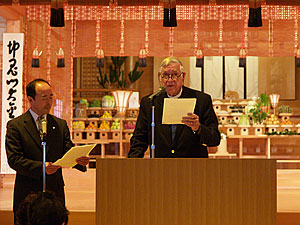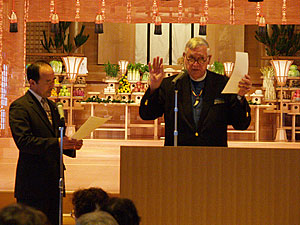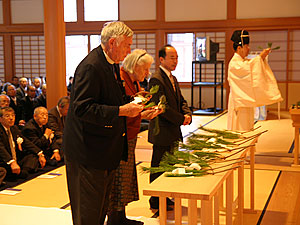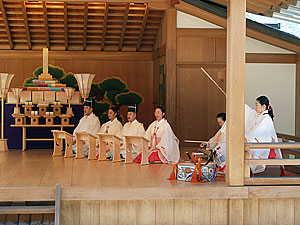A permanent memorial to Onisaburo
by James Parks Morton, Founder and Chair, Emeritus of The Interfaith Center of New York
A Speech by James Parks Morton at Autumn Grand Festival in commemoration of the Foundress, November 6, 2007
I am very grateful to be here at the Autumn Grand Festival today with you, the Spiritual Leader, Mme. Kurenai Deguchi, and the Oomoto followers.
The relationship between the Morton family and the Oomoto Community goes back 32 years, and is so rich and deep in friendship, in time together, in visits, exchange programs, trips together and shared projects, that we could talk together all day--not just ten minutes. So I will limit myself to seven high points.
1. It all began in March 1975 with the wonderful exhibition of Onisaburo's art at the Cathedral of St. John the Divine in New York, where I was Dean. First the month-long exhibition plus No Dance, Drums, Koto music and Tea ceremony--and most important, the Shinto Ritual of Purification at the High Altar. A second visit marked the 30th Anniversary of the United Nations in September 1975 and once again Oomoto offered their religious rituals and traditional Japanese arts in the weeklong celebration. Two visits to the Cathedral in 1975 and we became friends! Oomoto invited us to come to Ayabe in January 1977 to offer our Christian Ritual in their Shinto Shrine. 1977 truly changed our lives--two beautiful weeks in Japan--our first visit to your country, and a deep friendship. Suddenly I understood what "Interfaith" was. That trip convinced me that I wanted to make interfaith work a central part of my life.
2. In 1978 we began together a program of exchanges: Oomoto would send two young members to live at the Cathedral for two months--and the Cathedral would send two or more young members to the Oomoto Summer Program of Traditional Japanese Arts. Our daughter Polly came to that program in 1978 and it changed her life. In the years after 1978 I came to understand Onisaburo not only as an artist but perhaps the first major religious leader working explicitly for interfaith understanding and for world peace--the latter cause which led to his imprisonment for 12 years.
3. Oomoto and the Mortons made many trips together: to Prague, to Mount Sinai and Egypt, to Canterbury, and especially with the three week-long Global Forum Conferences: to Moscow in 1990, Rio in 1992, and Kyoto in 1994.
4. It is important to emphasize the depth of our mutual very personal friendship with Oomoto. Kyotaro and I call each other Brother. Our daughter Polly's exposure to traditional silk weaving at Oomoto convinced her to become a silk weaver, and in 1981 she returned to Oomoto for six months and lived with the Deguchi family and especially Madame Naohi. She is now a professional weaver of Japanese silk as her life's work.
5. When I retired from the Cathedral in January 1997 after 25 years as Dean I established the Interfaith Center of New York, and in 2000 we created the Onisaburo Art Gallery in our new building with a beautiful Onisaburo tea bowl "The Joy of Spring" and two tea bowls by Naohi as centerpieces. Kyotaro lectured at the Center on the life of Onisaburo in 2004 and also offered the Shinto prayer at the Center's Annual Interfaith prayers at the opening of the United Nations General Assembly in September.
6. In 2003-4 Mitsutako Innui and his wife Junko became part of the staff of the Interfaith Center as New York's first Shinto Priest. Also in 2004 Pamela and I were invited to attend the great exhibition of Onisaburo's art at the Kyoto Museum and had the special honor of meeting the new spiritual leader Kurenai Deguchi at lunch at Kameoka. And this past June the Center bestowed its Annual Interfaith Award on Kyotaro Deguchi and the amazing leadership of Onisaburo and his family and followers over the years. Tanakasan, who accepted the Center's Interfaith Award for Kyotaro also returned the "Joy of Spring" Teabowl of Onisaburo to the Center's Collection of Interfaith Art at its new permanent home at the Stony Point Conference Center.
7. My seventh and final high point focuses on our future plans for a significant permanent presence of Oomato in America--like the ministry at the Interfaith Center that Mitsutaka began. New York's huge Japanese population needs a Shinto Priest!! Attached and highlighting this Oomoto ministry would be a permanent memorial to Onisaburo in connection with the Interfaith Art Collection and the "Joy of Spring" teabowl. The Director of the Stony Point Conference Center, The Rev. Dr. William Pinder, hopes that we would construct an Onisaburo Interfaith Peace Pavilion on the 50 acre property of the Stony Point Conference Center. The distinguished prize-winning sculptor who designed and built the first Onisaburo Art Gallery, Mr. Stephen Glassman of Los Angeles, has made a very preliminary design which I will present to you as a starting point for our future plans.
My final point can be summed up as our enormous gratitude to Oomoto--to Onisaburo and his wonderful children and grandchildren and great grandchildren. All of You!!! It is so important that the interfaith, environmental, and world peace commitments of Oomoto, begun by Onisaburo, continue in America for generations to come.

Speech by James Parks Morton.


Pine bough offering at Autumn Grand Festival in commemoration of the Foundress, November 6, Ayabe.
New Contents Thu, May 20, 2010
- Oomoto participates in Sant’Egidio conference : Dialogue among religions and cultures : On divided island nation of Cyprus By Bill Roberts
- Photo Album : Portraits of three branches: Shoko, Tanegashima and Aomori By Bill Roberts
- Oomoto FAQ
- A Letter from Oomoto : Of mountains and myths By Bill Roberts
- Polyglot poem festival The Utamasturi is going international — what’s next? By Bill Roberts
- Ethics education program captures the spirit of Bankyo Dokon By Bill Roberts
- A Letter from Oomoto : A year’s worth of adventure in a summer of branch visits By Bill Roberts
- In Kumamoto, it’s all about water – and fire By Bill Roberts
- A speech by Nevada Taylor at the Kii Branch in Wakayama Prefecture on April 13, 2008.:An Encounter With Oomoto Through Aikido
- Utamatsuri, Poem Festival, in Tokyo(on April 17, 2008)
- A speech by Neil Ryan Walsh at the Kobe branch on Mar. 9th, 2008.:Planting the Seeds of the Soul
- Meeting with the Fifth Spiritual Leader of Oomoto, Madame Kurenai Deguchi by Neil Ryan Walsh
- A speech by Neil Ryan Walsh at the Nagoya branch on Feb. 17th, 2008.:The Japanese Arts beyond National Boundaries
- To the Oomoto branch in Nagoya: City of Eel and Toyota by Neil Ryan Walsh
- A Speech by Nissim Ben Shitrit, Ambassador of Israel on the occasion of the Oomoto Setsubun Grand Festival in Ayabe February 3rd, 2008 : Japan and Israel : Two Lands Balancing the Needs of Traditional Culture and Modern Life. r
- A permanent memorial to Onisaburo (A Speech at the Autumn Grand Festival , November 6, 2007 : )By James Parks Morton, Founder and Chair, Emeritus of The Interfaith Center of New York
- Israel, Palestine and the Power of Poetry(Oomoto believes small efforts can have lasting ripple effects on people and peace)By Bill Roberts
- “Something Great”(This genetics pioneer, a friend of Oomoto, offers a clue to the mystery of life)By Bill Roberts
- Kamishima Cleanup (Harima branch members regularly visit this sacred island to keep the shrine tidy)By Bill Roberts
- Kyotaro Deguchi was one of six recipients of the 2007 James Parks Morton Interfaith Award
What is Oomoto?
- What is Oomoto?
- Spirtual Centers
- Founders and Spiritual Leaders
- History
- Organization and activities
- Teachings and scriptures
- Art Works of Founders and Leaders
Opinions[Archive]
- Statement of regret for the outbreak of war against Iraq (March 20,2003)
- Jinrui Aizenkai dispatched the "Urgent Appeal for a World (Global) Crisis" on March 14.
Grappling with Bioethics[Archive]
- Oomoto’s support for abolishing the death penalty (12, June 2003)
- The Oomoto Foundation protests any birth of a human clone baby. (5, January 2003)
- OOMOTO'S VIEW REGARDING JAPAN’S PERMITION TO THE RESERCH OF HUMAN EMBRYONIC STEM CELLS (ES cells)(12, June 2000)
Vistor’s Review[Archive]
- A speech by Bill Roberts at the Oomoto branch in Hiroshima after its monthly service on March 18, 2007:Encounters with war and peace
- How Bankyo Dokon changed one life by Linda Macphee
- A speech by Bill Roberts at the Hokuriku (Kanazawa) branch on Dec. 3, 2006:Ritual and myth -an encounter with ‘divine madness’
- A speech by Bill Roberts at the Himeji Cultural Center on Feb. 25, 2007:Mesmerized by the Japanese Arts
- A speech by Bill Roberts at the Kobe branch on Feb. 11th, 2007.:There are just human tears and human joy
- A Speech on the occasion of the Oomoto Setsubun Grand Festival in Ayabe February 3rd, 2007 : Egypt's role in Middle East peace
- Keynote Speech for the 28th World Federation Japanese Religionists Conference for World Peace in Tokyo (at Kokugakuin University, Novermber 29, 2006):Vision for Peace in the Middle East By Dr. Munther S. Dajani, Professor Dean, Faculty of Arts, Al Quds University, Jerusalem
- A speech to the Kyoto branch:Spiritual adventures in researching Oomoto leaders
- A Speech at The Oomoto Foundation on Monday, November 6, 2006 : Jordan's role in Middle East By Samir Nouri, Ambassador of the Hashemite Kingdom of Jordan
- A letter from Oomoto:The Young People of Tottori
- A speech by Bill Roberts on the occasion of the dedication ceremony for the new shrine of Tottori Branch By Bill Roberts Oct. 8, 2006
- A speech by Bill Roberts at the Oomoto branch in Hiroshima after its monthly service on March 18, 2007:Encounters with war and peace
- How Bankyo Dokon changed one life by Linda Macphee
- A speech at Setsubun : A Portrait of Oomoto By Bill Roberts Feb. 3, 2006
- New Publication ! By Bill Roberts Feb. 3, 2006 A Portrait of Oomoto
you can read this book in html => http://www.jinruiaizenkai.jp/English/en-kolumno/en-bill/en-sugao/billbook1en.html
E-mail below to order brobert1@ix.netcom.com
Current Topics
- Prayer Offering and World Religious Forum II
- Living the art of dialogue
- Kyotaro Deguchi was one of six recipients of the 2007 James Parks Morton Interfaith Award
Books
Online Books
- Divine Signposts by Onisaburo DEGUCHI
- The Creation of Meaning by Hidemaru Deguchi
- Bankyo Dokon(Seventy years of Inter-Religious Activity at Oomoto)
- Nao Deguchi — A Biography of the Foundress of Oomoto
- The Great Onisaburo Deguchi published by Aiki News
- Bankyo Dokon Seventy Years of Inter-Religious Activity at Oomoto
- Insearch of Meaning
- Nao Deguchi A Biography of the Foundress of Oomoto
- A Portrait of Oomoto By Bill Roberts
Oomoto international Archive
- The History of Oomoto (Jan.– Mar. 1980 — Apr.– Jun. 1982)
- The Ancestors; Friends or Foes? (Apr.– Jun. 1987)
- Tsukinamisai; The Sabbath of Shinto (Jan.– Jun. 1983)
- The Poem Festival at Oomoto; An Ancient Rite Lives Again (Oct.– Dec. 1981)
- Purification of the Universe ; Oomoto's Setsubun Festival (Apr.– Jun. 1981)
Links
Flowers at Ten'on-kyo & Baisho-en (photographs)
Contact
All rights reserved : the Oomoto Foundation Produced by the Netinformational Commission
Since : Mar. 7.1998 Last Update : Thu, May 20, 2010
E-mail : webmaster@oomoto.or.jp
Top Page Nihongo Esperanto Português Roomazi



